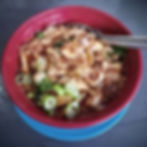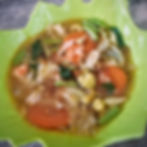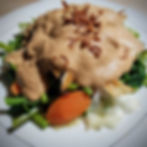INDONESIAN Food You Must Try
- Lisa
- Sep 17, 2019
- 8 min read
Updated: Mar 9, 2021
With 6 000 inhabited islands to choose from, Indonesian cuisine is wonderfully diverse and includes a vast variety of regional dishes found across the country. Javanese cuisine consists of an array of simply seasoned dishes, with predominant flavourings of peanuts, chillies and sugar. With the majority of Indonesians being Muslim, most dishes are considered Halal, with the exceptions and pork products predominantly only found in Bali. Vegetarians are also better catered for across Indonesia than in most other countries.
RELATED POSTS:
The etiquette of eating by hand
In Indonesia eating with your hand is very common, particularly amongst the locals. If you do choose to forego western utensils, just remember the one basic rule of etiquette to observe: Use only your right hand, as the left hand is used to clean yourself! The basic idea is to use the four fingers of your right hand to gather a small ball of rice, which can then be dipped into sauces before you pop it in your mouth by pushing it off the fingers with your thumb. Whatever you do, don't stick any of your hands into communal serving dishes: instead, serve yourself with utensils (using the left hand) and then dig into your meal. It's very important to always make sure to wash your hands well before and after eating.
Where to eat like a local
Our complete guide to Where to Eat Like A Local is available here.
A traditional food cart in Indonesia is called a “kaki lima” which literally means ”five legs”. This refers to the three wheels on the cart and the two legs of the vendor! At night a kaki lima can turn into a “lesehan” simply by providing some bamboo mats for customers to sit on and chat while eating. A better version of a “kaki lima” is an “angkringan”, which is a slightly bigger cart.
A step up from the “kaki lima” is the warung (or the old spelling waroeng), a less mobile stall offering much the same food, but perhaps a few plastic stools and a tarp for shelter. Usually people sell bakso (meatballs) or chicken porridge in these outlets. Rather more comfortable is the “rumah makan” or eating house, a simple restaurant more often than not specialising in a type of food or style of cuisine.
Nasi Padang restaurants, offering rice and an array of curries and other toppings to go along with it, are particularly popular and easily identified by their soaring Minangkabau roofs. Ordering at these is particularly easy: just sit down, and your table will promptly fill up with countless small plates of dishes. Eat what you like and pay for what you consumed.
Another mid-range budget option in larger cities is to look out for food courts and restaurants inside shopping malls, which combines the comfort of air-conditioning with hygienic if rather predictable food.
A restoran indicates more of Western-style eating experience, with air-con, table cloths, table service and prices to match. We usually either grab something to eat on the go from a kaki lima or sit down to enjoy some local cuisine with the locals at a warung.
NASI (Rice) is, of course, a local Indonesian staple and is served in so many different interesting ways:
Nasi Bubur: rice porridge with toppings, popular for breakfast.
Nasi Lontong and Ketupat: rice wrapped in leaves and cooked so it compresses into a cake.
Nasi Kuning: yellow spiced rice, usually moulded into a sharp cone called a tumpeng.
Nasi Padang: white steamed rice served with a selection of curries and other toppings.
Nasi Timbel: white steamed rice wrapped in a banana leaf.
Nasi Goreng (Fried Rice)
Essentially just wok stir-fried rice with a host of salty seasonings, this simple hot and freshly cooked popular street food is both cheap and delicious. Be sure to ask for “Nasi Goreng Special” if you want a fried egg added to the dish!

Nasi Uduk (Coconut Rice)
Known as nasi lemak in Malaysia, this fragrant and slightly sweet rice is cooked with coconut milk and cardamom. Popular for breakfast, it is often eaten with omelette and fried chicken but can be served with a variety of sides.

Nasi Campur (Mixed Rice)
Nasi campur literally just means mixed rice. Depending on the location and origin, a Nasi Campur vendor might serve several side dishes, including vegetables, fish, and meats. At a minimum, it will be a scoop of Nasi putih (steamed rice) accompanied by small portions of other dishes, which could include meats, vegetables, peanuts, eggs, and fried-shrimp krupuk. At local spots, it can be had for around IRD 10,000 - 15,000 and is by far the best value (and tasty!) lunch you will ever have. Just take care as it can be very hot and spicy!

MI or MIE (Noodles) are almost as popular as rice.
You will see plenty of Indomie, who is the world's largest instant noodle manufacturer.
Bakmi: boiled thin egg noodles served with a topping of your choice.
Kuetiaw: flat rice noodles fried with soy sauce.
Mie Goreng (Fried Noodles)
Indonesian Mie Goreng is usually prepared with yellow noodles, stir-fried in a hot wok with oil, garlic, egg, and a combination of ingredients that can include cabbage, tomatoes, onions, and any choice of meat. Mie goreng is a very popular street food.

SOTO (Soups) can be either broth-like or like a watery curry and are very common.
Sayur Asam: vegetables in a sour soup of tamarind.
Sayur Lodeh: vegetables in a soup of coconut milk and fish.
Soto Ayam: chicken broth with chicken shreds, vermicelli and various local ingredients.
Soto Betawi: known as Jakarta soup, it's prepared with beef and boiled with herbs such as lemongrass and Indonesian bay leaves, flavoured with candle-nut, galangal, garlic, and shallots. Often a combination of both fresh milk and coconut milk is added to make the soup creamy.

Bakso (Indonesian Meatballs)
A very popular street food dish, the minced meat is mixed with some tapioca starch which gives them their serious bouncy texture. Bakso will either be served with noodles and soup or dry with soup on the side.

Sop Konro (Beef Ribs Soup)
A Makassar dish from southern Sulawesi, beef ribs is simmered in a variety of fragrant spices including coriander, galangal, lemongrass, cinnamon, nutmeg, and bay leaves. The result is that the meat is so tender it just slides off the rib bones.
Rawon
This spicy beef soup is a speciality of East Java. Along with pieces of beef, one of the most important ingredients in cooking rawon is keluak, a type of nut which imparts a nutty taste with a hint of rye. Beef rawon is served with rice and complemented with baby bean sprouts, a squeeze of lime, and sambal.

Balinese Babi Guling (Roast Suckling Pig)
Bali, with its mostly Hindu population, has a unique variety of pork dishes. Babi Guling is flavoured with herbs and spices like ginger, garlic, shallots, and chillies. The pig is roasted until crispy and you’ll have to set out early for this dish before it sells out!

Sate Ayam (Chicken Satay)
The meat is marinated in sweet kecap manis soy sauce, before being grilled on an extremely hot charcoal fire. This means that the meat cooks quickly, leaving it juicy but also giving it a smoky flavour.

Sate Kambing (Goat Satay)
The meat is marinated in sweet kecap manis soy sauce, before being skewered. The skewers are typically grilled on an extremely hot charcoal fire, so the meat cooks quickly while leaving it smoky and juicy.
Sate Padang (Padang Satay)
Originally from Padang, on the west coast of Sumatra, Sate Padang skewers consist of a mix of meat, including beef, beef tongue, and offal. The meat is marinated in a mixture of spices before being grilled over flaming hot charcoal. The skewers are then served over sliced up compressed rice cake (ketupat) and covered in a thick brown sauce and sprinkled with crispy shallots.
Ikan Bakar (Grilled Fish)
Typically the fish is butterfly cut and rubbed in a sambal marinade before being grilled quickly over a scorchingly hot charcoal fire. This leaves the fish incredibly tasty and tender and it is usually served with either kecap manis or a variety of different sambal chilli sauces and rice.

Bebek Goreng (Fried Duck)
This deep-fried duck is the equivalent of well known deep-fried chicken. They are often very small, can be a little greasy and salty but are also rich in flavour. Served with rice, a few raw herbs like lemon basil and some sambal chilli sauce.
Bubur Ayam (Chicken Congee)
Chicken congee, or rice porridge, is one of the very common street food dishes in Indonesia. The rice is cooked until it’s thick and hearty and while it can be prepared with an assortment of toppings, chicken is one of the most popular.
Beef Rendang
Rendang is a dish that originates in the western part of Sumatra from the Minangkabau people. There are two main variations of rendang, the supposed original version that’s quite dry with all the spices coated onto the meat, and the other that has more of a curry gravy sauce. Redang makes use of spices like cinnamon, star anise, cardamom, and dry chillies, garlic, shallots are the essential ingredient is desiccated coconut, which gives the rendang curry a grainy texture.

Ayam Bakar (Grilled Chicken)
This grilled chicken will often still have bones and will usually be served with rice and sambal sauce.

Ayam Goreng (Deep Fried Chicken)
You may be able to choose which piece of chicken you prefer. This will usually be served with rice and sambal sauce. The chicken is battered and deep-fried and can often be rather spicy.
Cap Cay
Sometimes spelt cap cai, this Chinese style dish of stir-fried vegetables is a great supplement to any meal and also a great dish to share. You will get a variety of local vegetables in a tasty broth.

Gado-Gado / Lotek
Often described as a type of 'salad' made from slightly boiled, blanched or steamed vegetables, hard-boiled eggs, boiled potato, fried tofu and tempeh, served with rice wrapped in a banana leaf and with a peanut sauce dressing. Gado-gado is promoted as one of the 5 national dishes of Indonesia and was one of our favourites during our last visit to Indonesia - we made a video to show some of the food we ate at smaller restaurants.

Karedok
Similar to gado-gado, however the vegetables are finely chopped and mostly raw.
Ketoprak
This is a Jakarta originating dish that includes pieces of tofu, and rice vermicelli noodles, all flavoured with sweet salty peanut sauce.
Gudeg (Jackfruit Stew)
Considered as of the national dishes of Yogyakarta, gudeg is young jackfruit braised with palm sugar, coconut milk, bay leaves, lemongrass, and galangal, until it’s extremely tender. It is served with rice as a main dish but accompanied by a few other common side dishes that include chicken, and curried cow skin.

Tempeh (Fermented Soybean)
Also spelt Tempe, this is a preserved soybean cake, that’s kind of similar to tofu, but it uses whole soybeans and it’s fermented in a loaf sized shape. Tempe is very nutritious, packed full of protein and fibre. It's often eaten as a snack - dipped into sambal chilli sauce for extra flavour! You will also find Tempe is often added to Nasi Camur as a vegetarian option.

Pempek (Fishcakes)
Pempek is a unique type of fishcake that not only includes pureed fish but also tapioca starch to give it a chewy bouncy texture. The pempek are then usually deep-fried (although you can get them grilled as well), and served with noodles and a sauce that’s sweet, salty, and sour.
Perkedel
Indonesian deep-fried patties, made of ground potatoes, minced meat, peeled and ground corn or tofu, or minced fish. The name was adopted from the Dutch word “frikadel”.
Sapo
Of Chinese origin, this tofu dish is traditionally cooked and served in a clay pot. Sapo might be served plainly as a vegetarian dish, or with chicken, seafood (especially shrimp), minced beef or pork.
Pecel
A regional dish of Central Java of peanut sauce with spinach and bean sprouts.
Batagor
Deep-fried tofu pieces served with a peanut sauce. This is a delicious dish on its own or as a shared accompaniment.

